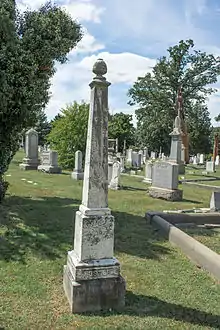A. Lawrence Foster
Abel Lawrence Foster (September 17, 1802 - May 21, 1877) was a United States Representative from New York.
Biography
A. Lawrence Foster was born on September 17, 1802, in Littleton, Massachusetts.[1] He studied law in Vernon, New York, was admitted to the bar and commenced practice in Morrisville, New York, in 1827.[2]
Foster ran unsuccessfully for Congress in 1838.[3] In 1840 he was elected as a Whig to the Twenty-seventh Congress (March 4, 1841, to March 3, 1843).[4] During his term Foster was Chairman of the Committee on Expenditures in the Department of the Treasury.[5] He did not run for reelection in 1842.

In 1844 he moved to a farm in Fairfax, Virginia, which included the land that is now Tysons Corner.[6][7] In the 1850s he served as a Fairfax County Commissioner.[8]
During the Civil War Foster supported the Union, and relocated temporarily to Washington, D.C. In 1862 he was appointed U.S. Indian Agent for the Chippewa of the Mississippi in Minnesota.[9]
After the Civil War he returned to Fairfax, and was appointed one of three U.S. Tax Commissioners for the northern part of the state after Virginia was readmitted to the Union.[10] In this capacity he was responsible for the sale to the federal government of the Robert E. Lee estate, which is now Arlington National Cemetery.[11]
Foster's health began to fail in the 1870s, after which he resided in Washington, D.C. He died there on May 21, 1877, and was buried in Glenwood Cemetery.[12][13]
In the 1890s his heirs petitioned Congress to compensate them nearly $29,000 (over $712,000 in 2009) for Foster's property and supplies that were used by the Union Army or destroyed by the Confederacy. In the early 1900s the United States Court of Claims authorized partial payment to resolve the case.[14]
References
- Town of Littleton, Records of Littleton, Massachusetts, 1900, page 159
- James Hadden Smith, History of Chenango and Madison Counties, New York, Part 2, 1880, page 631
- Benjamin Perley Poore, The Political Register and Congressional Directory, 1878, page 379
- Nathaniel Hickman, editor, The Politician's Register, 1840, page 20
- Niles' National Register, House of Representatives, Volume 61, December 25, 1841, page 269
- Dr. Donald J. Senese, Historians Tackled History of Tysons Corner Archived October 31, 2014, at the Wayback Machine, July 28, 2004
- American Agriculturist, Letters from Virginia -- No. 5, Volume 61, 1848, pages 122-123
- Virginia General Assembly, Acts of the General Assembly of Virginia, Passed in 1852, 1852, page 40
- Family Search.org, Chippewa Indian Agency (Minnesota), retrieved November 29, 2013
- United States Congress, Journal of the Executive Proceedings of the Senate of the United States, 1887, page 387
- U.S. Government Printing Office, Congressional Serial Set, 1874, page 141
- United States Congress, United States Congressional Serial Set, 1894, pages 119-120
- A. Lawrence Foster at Find a Grave
- U.S. Government Printing Office, Congressional Serial Set, page 412
External links
- United States Congress. "A. Lawrence Foster (id: F000296)". Biographical Directory of the United States Congress.
- A. Lawrence Foster biography at the Political Graveyard
- Foster Genealogy on Google Books
| U.S. House of Representatives | ||
|---|---|---|
| Preceded by Nehemiah H. Earll, Edward Rogers |
Member of the U.S. House of Representatives from New York's 23rd congressional district 1841–1843 with Victory Birdseye |
Succeeded by Orville Robinson |